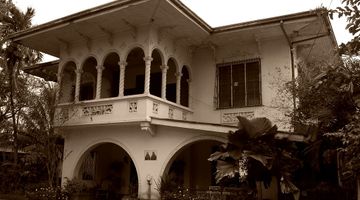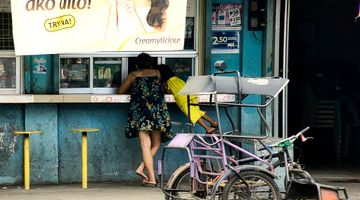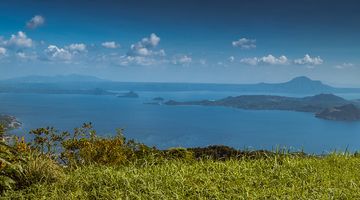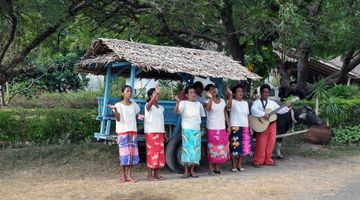Oslob Travel Guide
In a nutshell
In the same way that Siem Reap is known for Angkor Wat and Giza is known for the pyramids, Oslob is known for its whale sharks.
Why go to Oslob
Oslob is located at the southern tip of Cebu Island on the Cebu Strait. Tourists flock to the province for its white sand beaches and crystal clear waters and for up-close experiences with the largest fish in the world.
As with most of the Philippines, the Spaniards have left behind a legacy. This legacy includes the Baluarte, which means “watchtower” in Spanish, which was built in 1788 so that Spanish guards could look out over the water and be prepared for any impending naval threat. The watchtower was one of six that existed along the coast and is the only one remaining today.
The Spanish are also responsible for the construction of most of the churches in the area. In 1848, The Church of the Immaculate Conception was finished when Oslob became an independent Catholic parish. The church was destroyed in a fire during the Second World War, but was rebuilt in the 1950’s. In 2008, another fire destroyed parts of the church.
If you’re looking to get out of Oslob, Sumilon Island is the perfect option for a day trip. You can take a boat from the port, which shouldn’t cost much, and within a few minutes, you’ll be puling up on the island. The island is a marine sanctuary and is home to some of the best reefs and sea life you will see in the Philippines, and perhaps in the world. The island features four dive sites and a myriad of options if you just want to do some simple snorkelling. If you’re intending to stay on the island, you can book rooms at the Sumilon Bluewater Island Resort from PHP13,000 nightly. This hotel features a restaurant, bar and private beach.
And while yes, there are historical sites and nice beaches in and around Oslob, most people who come to the island are there for swimming with the mammoth (and harmless) whale sharks.
Whale shark activities actually take place outside of Oslob at Tan-Awan, which is about a 15-minute drive.
There are a number of tour operators that run trips out to see the gentle giants, including Island Trek Tours, AJ’s Place, and Oslob Whale Shark Watching.
Generally the whale shark tours are split into two different categories, simply whale watching, and actually snorkelling with them.
Some people are initially scared of getting into the water. Perhaps it’s because they have the word “shark” in their name, or perhaps it’s simply because of their incredible size, but many tourists initially express trepidation at first. Once the fear has worn off though, and they realize how docile these creatures are, they always recount how great a time they had. Both types of tour go for around PHP500, which is a small price to pay for a half day with the largest fish on the planet.
Because of how incredible it is to have an experience with these fish, it has become a mass tourist activity and if you want to avoid crowds, your best bet is to show up early, before the tour buses begin showing up.
When to go to Oslob
Oslob experiences wet seasons and dry seasons and if you’re planning on spending time at the beach, you’re best off going during the dry season which runs from February to September, with the wet season taking over from October to January.
Where to stay in Oslob
Lodgings in Oslob range from cheap backpacker budget options to high end resorts and every traveller should be able to find a place to lay their head that fits their budget.
If you want to stay near the whale sharks, you have two very good options, which are BCD’s Place and Brumini Beds and Beach Resort. Both of these hotels are in Tan-awan. Both of these options are relatively cheap and simple, with a room costing around PHP1500 nightly. These hotels feature air conditioning in the rooms, but not much else.
Where to eat in Oslob
The restaurant scene in Oslob is rather limited and the majority of the eating establishments are located on the beachfront. You also won't find the same quantity of street food carts in Oslob as you will in the rest of the Philippines. However, some of these restaurants provide a great dinner and wonderful views of the water.
One of the most sought-after restaurants in Oslob is The Big J’s International & Local Cuisine Restaurant. It serves Filipino and other pan-Asian cuisines and is a good option for vegetarians as well. If you are tiring of Asian food, they serve a continental menu as well. A meal for two will cost somewhere around PHP800.
If you’re looking to enjoy a meal by the water, you can count on the Noordzee Restobar as an option. It serves traditional Filipino cuisine as well as American/English bar food just steps from the water and a meal for two will probably run you around PHP600.
How to get around Oslob
The downtown area is small enough and you should be able to cover it on foot, but if you are interested in seeing the whale sharks, which so many people are, it’s best to take a taxi or tuk-tuk to Tan-awan, which shouldn’t cost more than PHP100.
How to get to and from Oslob
Buses to the city arrive and depart to and from Bato, Moalboal and Cebu. Depending on the quality of the bus and whether it has air conditioning, you can expect to pay around PHP150 for a trip to or from Cebu and less if you are going to a closer destination.
Is Oslob safe to visit?
Make sure that before going to Oslob, you have enough pesos in cash to get you through your time there because there are no ATMs anywhere in the province. Oslob is as safe a city as any other small Southeast Asian city. There is little to no violent crime, but be sure to keep an eye out for pickpockets, which seem to be found everywhere in the world.

































































